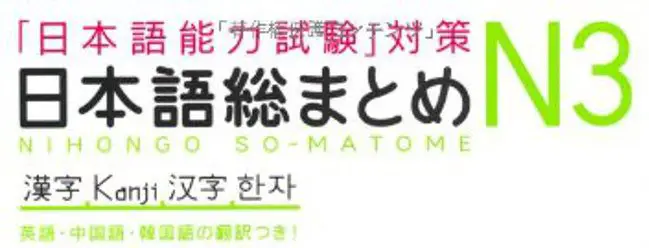If you read my review of the So-Matome N3 Grammar book a couple of weeks ago, you’ll know that N3 is a different beast to tame. One that book publishers are still kind of guessing about. How much is on it? What kanji is on it? How difficult is the reading?
And So-Matome, a fairly reputable publishing company in the Japanese language learning world has tried their best at hitting the mark with their series of books. They are generally a lot more gentler on you than the Kanzen Master series, but that doesn’t mean they are useless. They have a good place if you use them right.
Format
This book, like most of the other So-Matome books is based on a 6-week study plan. Each day has one page that introduces 8-10 kanji. There is a good sketch on top where the artist has placed the kanji in the kind of places you would see them. For example, at pedestrian crossing you might see kanji for ‘push’ and ‘signal’ and other good examples.
Below the drawing for each day, it lists the kanji, their common readings, and some common example compounds and words to give you a good idea of when each of the readings are used. You can use this later on as a good reference.
The interesting thing is that it lists the readings of the kanji, but not the meaning. It only gives you example words that use that kanji. In this way, you are left to figure it out the general meaning of the kanji on your own, which is better than them giving you some weird meaning that you have a hard time getting a grasp on.
The second page has 3 quizzes that go over various ways to practice the readings. Sometimes this involves picking synonyms and sometimes it involves picking the best word for the sentence, which is a common question on the actual test. There are also the other standard types of questions as well – given a certain compound what is the reading, given a reading, what is the compound.
Some of these answers can be found on the first page, while others you need to puzzle out on your own based on previous knowledge you have from the N4 or other reading. It doesn’t really hand you anything, which is a good thing. Again, you have to think for yourself and make an educated guess.
The 7th day of each week finishes with an overall reading test for all the kanji that you went over in the week. This end of the week test has 20 questions that are formatted just like the JLPT, so you can get some real drill practice. There is also one ‘fun’ page involving some different kanji you haven’t seen yet, and then you are done for the week.
What I like About It
Like all the So-Matome books, it is very well organized and has a clear patterned to it. It is very easy to keep to your study plan as you work through each week learning the kanji. And the practice tests are very bite-sized so that you can work through them even if you are so busy that you have to squeeze studying sessions in between little moments you have.
And like I said before, the answers aren’t handed to you, so you actually have to think out how to answer, which gives you some fairly realistic practice for the test where you will inevitably run into words you don’t know.
You can also use this book as a handy reference for looking up kanji that you saw and learning a little more about them. There is an index of all the kanji in the back which is organized by stroke count. This tends to be a fairly easy way to look up kanji when you are still a bit of a novice.
What I don’t like About It
The So-Matome books are really good at introducing you to things you need to know for the N3, but sometimes they can hold your hand a little too much. Even though you need to struggle through some of the answers, there isn’t a lot of hard work that needs to be done in order to get through this. It’s just too easy to mindlessly drill through it and not soak up much.
It also doesn’t really recognize the fact that there are now plenty of smartphone apps and online tools that can help you learn the kanji more effectively and with better ways to review. I loved to see online tools that connect with these offline paper tools sometime in the future, but I guess we will have to keep waiting.
Overall
This isn’t a bad book at all. It is just really hard to study for the N3. You need to find material that is more difficult than average but yet simple enough to work your way through it. That can be a very difficult balancing act to do. Because part of you wants to just start using real native materials and get away from all the phony learner’s material.
How I would use this book is to start doing some native reading of easier kid books, or more ‘prepared’ reading, material that is specifically written with learner’s in mind. For example, material from Japanesepod101 (the ‘kanji’ version of their scripts). And then when you encounter a word you don’t recognize using this for reference.
Of course, you will need to supplement that with general drilling that covers N3 using something like Anki or Memrise.
You can pick it up at Amazon Japan, Amazon US, worldwide from White Rabbit, or at any big bookstore in a major Japanese city.
Have you tried this book? Was it helpful for you? Let me know in the comments below.











